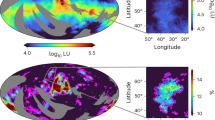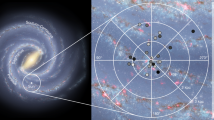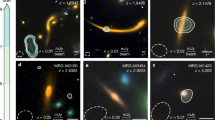Abstract
The James Webb Space Telescope (JWST) has revealed unexpectedly rapid galaxy assembly in the early Universe, in tension with galaxy-formation models1,2,3. At the low abundances of heavy elements (metals) and dust typical in early galaxies, the formation of molecular hydrogen and its connection to star formation remain poorly understood. Some models predict that stars form in predominantly atomic gas at low metallicity4,5, in contrast to molecular gas at higher metallicities6. Despite repeated searches7, cold molecular gas has not yet been observed in any galaxy below 7% solar metallicity8. Here we report the detection of rotational emission from molecular hydrogen near the only O-type star in the 3% solar metallicity galaxy Leo P (refs. 9,10) with JWST’s Mid-Infrared Instrument/Medium Resolution Spectroscopy (MIRI-MRS) observing mode. These observations place a lower limit on Leo P’s molecular gas content, and modelling of the photodissociation region illuminated by the O star suggests a compact (≤2.6 pc radius), approximately 104 M⊙ cloud. We also report a stringent upper limit on carbon monoxide (CO) emission from a deep search with the Atacama Large Millimeter/submillimeter Array (ALMA). Our results highlight the power of MIRI-MRS to characterize even small ultraviolet-illuminated molecular clouds in the low-metallicity regime, in which the traditional observational tracer CO is uninformative. This discovery pushes the limiting metallicity at which molecular gas is present in detectable quantities more than a factor of two lower, providing crucial empirical guidance for models of the interstellar medium in early galaxies.
This is a preview of subscription content, access via your institution
Access options
Access Nature and 54 other Nature Portfolio journals
Get Nature+, our best-value online-access subscription
$32.99 / 30 days
cancel any time
Subscribe to this journal
Receive 51 print issues and online access
$199.00 per year
only $3.90 per issue
Buy this article
- Purchase on SpringerLink
- Instant access to full article PDF
Prices may be subject to local taxes which are calculated during checkout


Similar content being viewed by others
Data availability
JWST MIRI-MRS data from programme GO-3449 will be available to download from the Mikulski Archive for Space Telescopes (https://mast.stsci.edu) as of 23 May 2025. Data for ALMA Project 2013.1.00397.S are available to download from the ALMA archive (https://almascience.nrao.edu/alma-data). Results from the PDR modelling are available from the authors on request. All other data in this paper have been previously published.
Code availability
The JWST Science Calibration Pipeline is available at https://github.com/spacetelescope/jwst. The CASA software used to process the ALMA data is available at https://casa.nrao.edu. Code to measure and analyse the H2 emission line intensities, uncertainties and upper limits is available at https://github.com/ogtelford/LeoPH2MRS. The PDR modelling software is available at https://github.com/scog1234/SGPDR.
References
Labbé, I. et al. A population of red candidate massive galaxies ~600 Myr after the Big Bang. Nature 616, 266–269 (2023).
Boylan-Kolchin, M. Stress testing ΛCDM with high-redshift galaxy candidates. Nat. Astron. 7, 731–735 (2023).
Carniani, S. et al. Spectroscopic confirmation of two luminous galaxies at a redshift of 14. Nature 633, 318–322 (2024).
Glover, S. C. O. & Clark, P. C. Star formation in metal-poor gas clouds. Mon. Not. R. Astron. Soc. 426, 377–388 (2012).
Krumholz, M. R. Star formation in atomic gas. Astrophys. J. 759, 9 (2012).
Schinnerer, E. & Leroy, A. K. Molecular gas and the star-formation process on cloud scales in nearby galaxies. Annu. Rev. Astron. Astrophys. 62, 369–436 (2024).
Warren, S. R. et al. CARMA CO observations of three extremely metal-poor, star-forming galaxies. Astrophys. J. 814, 30 (2015).
Shi, Y. et al. Oversized gas clumps in an extremely metal-poor molecular cloud revealed by ALMA’s parsec-scale maps. Astrophys. J. 892, 147 (2020).
Skillman, E. D. et al. ALFALFA discovery of the nearby gas-rich dwarf galaxy Leo P. III. An extremely metal deficient galaxy. Astron. J. 146, 3 (2013).
McQuinn, K. B. W. et al. Leo P: an unquenched very low-mass galaxy. Astrophys. J. 812, 158 (2015).
Bolatto, A. D. et al. The state of the gas and the relation between gas and star formation at low metallicity: the Small Magellanic Cloud. Astrophys. J. 741, 12 (2011).
Leroy, A. K. et al. Molecular gas and star formation in nearby disk galaxies. Astron. J. 146, 19 (2013).
Hunter, D. A., Elmegreen, B. G. & Madden, S. C. The interstellar medium in dwarf irregular galaxies. Annu. Rev. Astron. Astrophys. 62, 113–155 (2024).
Maloney, P. & Black, J. H. ICO/N(H2) conversions and molecular gas abundances in spiral and irregular galaxies. Astrophys. J. 325, 389–401 (1988).
Wolfire, M. G., Hollenbach, D. & McKee, C. F. The dark molecular gas. Astrophys. J. 716, 1191–1207 (2010).
Bolatto, A. D., Wolfire, M. & Leroy, A. K. The CO-to-H2 conversion factor. Annu. Rev. Astron. Astrophys. 51, 207–268 (2013).
Bisbas, T. G., Tan, J. C. & Tanaka, K. E. I. Photodissociation region diagnostics across galactic environments. Mon. Not. R. Astron. Soc. 502, 2701–2732 (2021).
Hu, C.-Y., Sternberg, A. & van Dishoeck, E. F. Metallicity dependence of the H/H2 and C+/C/CO distributions in a resolved self-regulating interstellar medium. Astrophys. J. 920, 44 (2021).
Hu, C.-Y., Schruba, A., Sternberg, A. & van Dishoeck, E. F. Dependence of XCO on metallicity, intensity, and spatial scale in a self-regulated interstellar medium. Astrophys. J. 931, 28 (2022).
Bialy, S. & Sternberg, A. CO/H2, C/CO, OH/CO, and OH/O2 in dense interstellar gas: from high ionization to low metallicity. Mon. Not. R. Astron. Soc. 450, 4424–4445 (2015).
Bialy, S. & Sternberg, A. Thermal phases of the neutral atomic interstellar medium from solar metallicity to primordial gas. Astrophys. J. 881, 160 (2019).
Roussel, H. et al. Warm molecular hydrogen in the Spitzer SINGS galaxy sample. Astrophys. J. 669, 959–981 (2007).
Togi, A. & Smith, J. D. T. Lighting the dark molecular gas: H2 as a direct tracer. Astrophys. J. 830, 18 (2016).
Hunt, L. K., Thuan, T. X., Izotov, Y. I. & Sauvage, M. The Spitzer view of low-metallicity star formation. III. Fine-structure lines, aromatic features, and molecules. Astrophys. J. 712, 164–187 (2010).
Naslim, N. et al. Molecular hydrogen emission in the interstellar medium of the Large Magellanic Cloud. Mon. Not. R. Astron. Soc. 446, 2490–2504 (2015).
McQuinn, K. B. W. et al. The Leoncino dwarf galaxy: exploring the low-metallicity end of the luminosity–metallicity and mass–metallicity relations. Astrophys. J. 891, 181 (2020).
Rubio, M. et al. Dense cloud cores revealed by CO in the low metallicity dwarf galaxy WLM. Nature 525, 218–221 (2015).
Evans, C. J. et al. First stellar spectroscopy in Leo P. Astron. Astrophys. 622, A129 (2019).
Telford, O. G., Chisholm, J., McQuinn, K. B. W. & Berg, D. A. Far-ultraviolet spectra of main-sequence O stars at extremely low metallicity. Astrophys. J. 922, 191 (2021).
Telford, O. G., McQuinn, K. B. W., Chisholm, J. & Berg, D. A. The ionizing spectra of extremely metal-poor O stars: constraints from the only H ii region in Leo P. Astrophys. J. 943, 65 (2023).
Telford, O. G. et al. Observations of extremely metal-poor O stars: weak winds and constraints for evolution models. Astrophys. J. 974, 85 (2024).
McQuinn, K. B. W. et al. The ancient star formation history of the extremely low-mass galaxy Leo P: an emerging trend of a post-reionization pause in star formation. Astrophys. J. 976, 60 (2024).
Aloisi, A. et al. I Zw 18 revisited with HST ACS and Cepheids: new distance and age. Astrophys. J. Lett. 667, L151–L154 (2007).
Izotov, Y. I. et al. SBS 0335-052, a probable nearby young dwarf galaxy: evidence pro and con. Astrophys. J. 476, 698–711 (1997).
Giovanelli, R. et al. ALFALFA discovery of the nearby gas-rich dwarf galaxy Leo P. I. H i observations. Astron. J. 146, 15 (2013).
Bernstein-Cooper, E. Z. et al. ALFALFA discovery of the nearby gas-rich dwarf galaxy Leo P. V. Neutral gas dynamics and kinematics. Astron. J. 148, 35 (2014).
Shi, Y. et al. Carbon monoxide in an extremely metal-poor galaxy. Nat. Commun. 7, 13789 (2016).
McKee, C. F. & Ostriker, E. C. Theory of star formation. Annu. Rev. Astron. Astrophys. 45, 565–687 (2007).
Topping, M. W. et al. Searching for extremely blue UV continuum slopes at z = 7–11 in JWST/NIRCam imaging: implications for stellar metallicity and ionizing photon escape in early galaxies. Astrophys. J. 941, 153 (2022).
Atek, H. et al. Most of the photons that reionized the Universe came from dwarf galaxies. Nature 626, 975–978 (2024).
Bushouse, H. et al. JWST calibration pipeline. Zenodo https://doi.org/10.5281/zenodo.6984365 (2025).
Spilker, J. S. et al. Spatial variations in aromatic hydrocarbon emission in a dust-rich galaxy. Nature 618, 708–711 (2023).
Argyriou, I. et al. JWST MIRI flight performance: the Medium-Resolution Spectrometer. Astron. Astrophys. 675, A111 (2023).
Law, D. R. et al. A 3D drizzle algorithm for JWST and practical application to the MIRI Medium Resolution Spectrometer. Astron. J. 166, 45 (2023).
Burton, M. G., Hollenbach, D. J. & Tielens, A. G. G. Mid-infrared rotational line emission from interstellar molecular hydrogen. Astrophys. J. 399, 563–572 (1992).
Roueff, E. et al. The full infrared spectrum of molecular hydrogen. Astron. Astrophys. 630, A58 (2019).
Herbst, T. M. et al. A near-infrared spectral imaging study of T Tau. Astron. J. 111, 2403 (1996).
Hunter, G. H., Clark, P. C., Glover, S. C. O. & Klessen, R. S. Towards the impact of GMC collisions on the star formation rate. Mon. Not. R. Astron. Soc. 519, 4152–4170 (2023).
Gong, M., Ostriker, E. C. & Wolfire, M. G. A simple and accurate network for hydrogen and carbon chemistry in the interstellar medium. Astrophys. J. 843, 38 (2017).
Habing, H. J. The interstellar radiation density between 912 A and 2400 A. Bull. Astron. Inst. Neth. 19, 421 (1968).
Sembach, K. R., Howk, J. C., Ryans, R. S. I. & Keenan, F. P. Modeling the warm ionized interstellar medium and its impact on elemental abundance studies. Astrophys. J. 528, 310–324 (2000).
Bakes, E. L. O. & Tielens, A. G. G. M. The photoelectric heating mechanism for very small graphitic grains and polycyclic aromatic hydrocarbons. Astrophys. J. 427, 822 (1994).
Wolfire, M. G., McKee, C. F., Hollenbach, D. & Tielens, A. G. G. M. Neutral atomic phases of the interstellar medium in the galaxy. Astrophys. J. 587, 278–311 (2003).
Rémy-Ruyer, A. et al. Gas-to-dust mass ratios in local galaxies over a 2 dex metallicity range. Astron. Astrophys. 563, A31 (2014).
Draine, B. T. et al. Dust masses, PAH abundances, and starlight intensities in the SINGS galaxy sample. Astrophys. J. 663, 866–894 (2007).
Engelbracht, C. W. et al. Metallicity effects on dust properties in starbursting galaxies. Astrophys. J. 678, 804–827 (2008).
Whitcomb, C. M. et al. The metallicity dependence of PAH emission in galaxies. I. Insights from deep radial Spitzer spectroscopy. Astrophys. J. 974, 20 (2024).
Hu, C.-Y., Sternberg, A. & van Dishoeck, E. F. Coevolution of dust and chemistry in galaxy simulations with a resolved interstellar medium. Astrophys. J. 952, 140 (2023).
Girichidis, P. et al. Physical processes in star formation. Space Sci. Rev. 216, 68 (2020).
CASA Team et al. CASA, the Common Astronomy Software Applications for radio astronomy. Publ. Astron. Soc. Pac. 134, 114501 (2022).
Schruba, A. et al. A molecular star formation law in the atomic-gas-dominated regime in nearby galaxies. Astron. J. 142, 37 (2011).
Schruba, A. et al. Low CO luminosities in dwarf galaxies. Astron. J. 143, 138 (2012).
Grenier, I. A., Casandjian, J.-M. & Terrier, R. Unveiling extensive clouds of dark gas in the solar neighborhood. Science 307, 1292–1295 (2005).
Jameson, K. E. et al. First results from the Herschel and ALMA spectroscopic surveys of the SMC: the relationship between [C ii]-bright gas and CO-bright gas at low metallicity. Astrophys. J. 853, 111 (2018).
Madden, S. C. et al. Tracing the total molecular gas in galaxies: [CII] and the CO-dark gas. Astron. Astrophys. 643, A141 (2020).
Astropy Collaboration et al. Astropy: a community Python package for astronomy. Astron. Astrophys. 558, A33 (2013).
Astropy Collaboration et al. The Astropy Project: building an open-science project and status of the v2.0 core package. Astron. J. 156, 123 (2018).
Aver, E. et al. A comprehensive chemical abundance analysis of the extremely metal poor Leoncino Dwarf galaxy (AGC 198691). Mon. Not. R. Astron. Soc. 510, 373–382 (2022).
Perez, F. & Granger, B. E. IPython: a system for interactive scientific computing. Comput. Sci. Eng. 9, 21–29 (2007).
Hunter, J. D. Matplotlib: a 2D graphics environment. Comput. Sci. Eng. 9, 90–95 (2007).
van der Walt, S., Colbert, S. C. & Varoquaux, G. The NumPy array: a structure for efficient numerical computation. Comput. Sci. Eng. 13, 22–30 (2011).
Harris, C. R. et al. Array programming with NumPy. Nature 585, 357–362 (2020).
Joye, W. A. & Mandel, E. New features of SAOImage DS9. In Astronomical Data Analysis Software and Systems XII, Astronomical Society of the Pacific Conference Series, Vol. 295 (eds Payne, H. E., Jedrzejewski, R. I. & Hook, R. N.) 489 (ASP, 2003).
Virtanen, P. et al. SciPy 1.0: fundamental algorithms for scientific computing in Python. Nat. Methods 17, 261–272 (2020).
Ginsburg, A. et al. radio-astro-tools/spectral-cube: v0.4.4. Zenodo https://doi.org/10.5281/zenodo.591639 (2019).
Acknowledgements
Based on observations with the NASA/ESA James Webb Space Telescope obtained from the Mikulski Archive for Space Telescopes (MAST) at the Space Telescope Science Institute, which is operated by the Association of Universities for Research in Astronomy, Incorporated, under NASA contract NAS5-26555. Support for this work was provided by NASA through grant JWST-GO-3449 from the Space Telescope Science Institute under NASA contract NAS5-26555. O.G.T. acknowledges support from a Carnegie-Princeton Fellowship through Princeton University and the Carnegie Observatories. This research was supported in part by grant NSF PHY-2309135 to the Kavli Institute for Theoretical Physics (KITP). S.C.O.G. acknowledges financing from the European Research Council through the ERC Synergy Grant ‘ECOGAL’ (project ID 855130) and from the German Excellence Strategy through the Heidelberg Cluster of Excellence ‘STRUCTURES’ (EXC 2181 - 390900948). A.D.B. acknowledges support from the NSF under award AST-2108140. This paper makes use of Atacama Large Millimeter/submillimeter Array (ALMA) data. ALMA is a partnership of ESO (representing its member states), NSF (USA) and NINS (Japan), together with NRC (Canada), MOST and ASIAA (Taiwan) and KASI (Republic of Korea), in cooperation with the Republic of Chile. The Joint ALMA Observatory is operated by ESO, AUI/NRAO and NAOJ. The National Radio Astronomy Observatory is a facility of the National Science Foundation operated under cooperative agreement by Associated Universities, Inc. This research used NASA Astrophysics Data System Bibliographic Services, adstex and the arXiv preprint server. The following software was used in this analysis: Astropy66,67,68, iPython69, Matplotlib70, NumPy71,72, SAOImageDS9 (ref. 73), SciPy74, CASA60 and SpectralCube75.
Author information
Authors and Affiliations
Contributions
O.G.T., K.M.S. and K.B.W.M. developed the JWST proposal. O.G.T. (PI of JWST-GO-3449) analysed the H2 emission lines in the MIRI-MRS observations of Leo P, made Figs. 1 and 2 and wrote the manuscript. K.M.S. led the design of the JWST observations and reduced the MIRI-MRS data. S.C.O.G. modelled the PDR to constrain the emitting H2 temperature and made Extended Data Fig. 1. E.J.T. reduced the ALMA data and calculated the upper limit on LCO in Leo P. A.D.B., R.J.R.V. and all authors contributed to interpretation of the results and to the manuscript.
Corresponding author
Ethics declarations
Competing interests
The authors declare no competing interests.
Peer review
Peer review information
Nature thanks Chia-Yu Hu and the other, anonymous, reviewer(s) for their contribution to the peer review of this work.
Additional information
Publisher’s note Springer Nature remains neutral with regard to jurisdictional claims in published maps and institutional affiliations.
Extended data figures and tables
Extended Data Fig. 1 PDR modelling suggests a low temperature for the detected H2.
H2 S(1) emission-weighted mean temperature (T) as a function of density (n) for our simple one-dimensional PDR models of the warm H2 in Leo P (see Methods for details). These calculations assume a slab symmetry for the emitting gas, with a thickness L = 1 pc and a uniform density as indicated in the figure. The slab is illuminated by the radiation field produced by the O star in Leo P, which has a strength of χ = 200 in Habing units50. Results are shown for three different values for the cosmic ray (CR) ionization rate: ζH = 10−19 s−1 (black line), ζH = 10−18 s−1 (blue line) and ζH = 10−17 s−1 (red line).
Supplementary information
Supplementary Information
This file contains further descriptions of the JWST MIRI-MRS observation design; the impacts of our assumptions on the warm H2 temperature and mass limits; an alternative measurement of the upper limit on LCO; and implications for Leo P’s total H2 mass and CO-to-H2 conversion factor.
Rights and permissions
Springer Nature or its licensor (e.g. a society or other partner) holds exclusive rights to this article under a publishing agreement with the author(s) or other rightsholder(s); author self-archiving of the accepted manuscript version of this article is solely governed by the terms of such publishing agreement and applicable law.
About this article
Cite this article
Telford, O.G., Sandstrom, K.M., McQuinn, K.B.W. et al. Molecular hydrogen in the extremely metal- and dust-poor galaxy Leo P. Nature 642, 900–904 (2025). https://doi.org/10.1038/s41586-025-09115-7
Received:
Accepted:
Published:
Issue date:
DOI: https://doi.org/10.1038/s41586-025-09115-7



